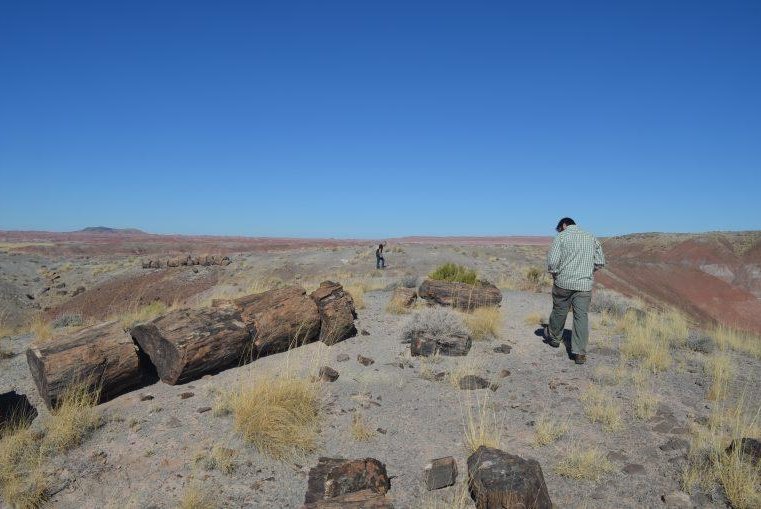
Geologists walk across Arizona’s Petrified Forest National Park, one the many places across the American Southwest that has experienced intense drought conditions over the last two decades. Photo by Kevin Krajick/Earth Institute
April 17 (UPI) -- Across much of the Western United States, a megadrought is underway. And according to a study published this week in the journal Science, anthropogenic climate change is at least partially to blame.
"Global warming has pushed what would have been a moderate drought in southwestern North America into megadrought territory," researchers wrote in the paper.
Scientists used soil and tree-ring analysis, as well as hydrological modeling, to show that the nearly two-decade span from 2000 to 2018 was the driest 19-year period in more than four centuries.
Tree ring data dating back to 800 A.D. helped scientists identify a handful of prolonged droughts, similar in severity to the current megadrought. Soil moisture data allowed scientists to characterize the level of dryness experienced over the last two decades.
RELATED Drylands to become more abundant, less productive due to climate change
The analysis showed only one earlier drought was comparable to the ongoing drought. The period from 1575 to 1603 was the last time the region experienced such a prolonged and intense drought.
The latest megadrought has been most intense across the American Southwest, especially in Southern California and Arizona. But the megadrought is ongoing and continues to expand, with below-average precipitation plaguing a large swath of the country, stretching from Oregon and Montana down through California, New Mexico and portions of northern Mexico.
According to the new study, natural climate patterns play a significant role in the occurrence of megadroughts. Unusually cool weather across the tropical Pacific Ocean -- the so-called La Niña pattern -- tends to push storm tracks farther north, starving the Southwestern U.S. of much-needed precipitation.
RELATED Australia's wildfires burned 21 percent of the country's temperate forests
Researchers determined the current drought has been exacerbated by human-caused climate change. As a result of global warming, average temperatures in the region have risen some 2.2 degrees Fahrenheit over the last two decades. Because hot air holds more moisture, prolonged heat waves can pull large amounts of moisture from the soil, making drought conditions worse.
The scientific community isn't in agreement on exactly what constitutes a megadrought. Generally speaking, a megadrought is defined as a drought persisting across decades, but the specific parameters are contentious.
But the authors of the latest study suggest a tidy definition of a megadrought isn't needed to determine whether climate change is significantly worsening current drought conditions.
RELATED El Niño weather patterns blamed for declines in insect biodiversity
"It doesn't matter if this is exactly the worst drought ever," study co-author Benjamin Cook, climate scientist at the Goddard Institute for Space Studies, said in a news release. "What matters is that it has been made much worse than it would have been because of climate change."
Because temperatures are expected to continue rising for the foreseeable future -- and until humans dramatically reduce greenhouse gas emissions -- Cook suggests the current drought is likely to persist. If the drought does subside, it's likely another will begin soon after.
"Because the background is getting warmer, the dice are increasingly loaded toward longer and more severe droughts," said lead study author Park Williams, a bioclimatologist at Columbia University's Lamont-Doherty Earth Observatory. "We may get lucky, and natural variability will bring more precipitation for a while. But going forward, we'll need more and more good luck to break out of drought, and less and less bad luck to go back into drought."
No comments:
Post a Comment